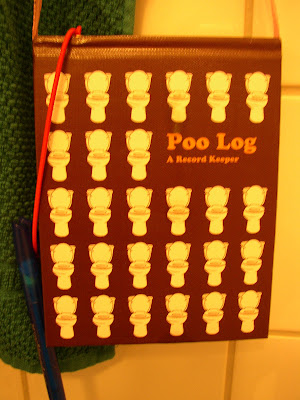Have family gatherings become boring lately? Everyone being too kind and considerate for comfort? Uncle Lester quit drinking and Cousin Gertrude finally got laid and calmed the fuck down? Well, if that's the case, your problems are finally at an end, thanks to
Peta (People for the Ethical Treatment of Animals). Their toilet paper features information about bacterial contamination in slaughterhouses, guaranteed to get everyone riled up and nervous. Uncle Lester will be reaching for the whisky and making aggressive comments about "those goddamned hippies" in no time, and Cousin Gertrude and Great-Aunt Myrtle are pretty much guaranteed to start a heated discussion about the merits of vegetarianism, reinforcing their arguments with broken bottles.
Stock up on this for the next family get-together (make sure there's a meat course), aggregate a plentiful supply of booze, and you'll be happily feuding for the next decade at least!
In other news,
Andrex, the toilet paper
we love to hate, has launched a new Eco toilet paper, made entirely from recycled paper and featuring bamboo fibres. Bamboo "is one of the fastest growing plants in the world producing significantly
more fibre, on less land, than trees traditionally used to make tissue
paper" says Tom Berry, head of sustainability at Kimberly-Clark EMEA, interviewed by
Businessgreen. Bamboo also consumes relatively little water when growing, which is of course great from an ecological perspective.
Asked why Andrex hasn't produced toilet paper made from 100 % recycled fibres before, they
reply, "Until now, we were not able to produce a recycled toilet tissue that we were happy
with in terms of the quality and softness consumers would expect from market leaders
Andrex". Andrex are also anxious to reassure consumers that bamboo is "safe for use in toilet tissue". Naturally, one would expect people to be worried about the effect of a rough, alien fibre on their soft, pampered bottoms.
We still don't get the obsession with soft toilet paper. We really. Really. Don't get it.
 |
| That hateful puppy. Image from The Guardian. Illustration: www.jonathan-e.com |
Just thinking about that stupid puppy makes us all irascible. Let's contemplate some soothing historical toilet facts before someone gets hurt!
Blogger
Bukisa writes,
The so-called "Room of the Seven Sages", in Ostia (the harbor city of
Rome) has painted walls, depicting seven of the greatest Greek
philosophers, with ironic texts about their bathroom activities, such as "The cunning Chilon taught how to flatulate unnoticed" and "No one will
give you a long lecture, Priscianus, as long as you use the sponge"
(the sponge was the Romans’ equivalent for toilet paper).
 |
| Roman toilet goers. Image from I.ytimg |
For more information about lavatory sponges, and an unforgettable image of the
assistant curator at the Roman Bath Museum in York wielding one,
look no further.
John R. Clarke expostulates, in his book
Art in the Lives of Ordinary Romans: Visual Representation and Non-elite Viewers in Italy, 100 B.C.-A.D. 315 (Berkeley: University of California Press, 2003):
The tavern paintings in the Caupona of the Baths of the Seven Sages at Ostia Antica date to about 100. [...] The artist attributes absurd bowel-movement techniques to the venerable voices of wisdom, the Seven Sages of the seventh century B.C., and he pairs their images with those of ordinary men in the act of shitting.
[...] On the right (west) side of the same wall follows Thales of Miletus, framed by the Greek words thales and meilhsios. [...] Here too, the artist has written the joke in Latin above the venerable sage from Miletus: Durum cacantes monuit ut nitant Thales, or “Thales advised those who shit hard to really work at it.” There is a fragmentary inscription below the Sage that includes the words [u]taris xylosphongio, or “use the sponge on wood”; since Romans used sponges to clean themselves after defecation, one scholar proposes that the phrase suggests using the philospher’s staff for this purpose.
(p. 170)
Let's have some proper, scholarly, linguistic musings as well.
We found a pretty hardcore history blog called
Laudator Temporis Acti. The author writes, quoting a play by Aristophanes:
XANTHIAS: Hey, what's happened to you?
DIONYSUS: "The bowel is empty [ἐγκέχοδα]: call upon the god!"
XANTHIAS: Get up, won't you, quickly, you ridiculous fool, before anyone else sees you!
DIONYSUS [rising]: I feel I might faint. Give me a sponge [σφογγιάν] for my heart.
XANTHIAS [producing a sponge from the luggage-bundle and offering it to Dionysus]: Here, take it. [Dionysus lifts his clothes with his left hand; his right hand, holding the sponge, disappears behind his back.] Where is it? [Moving round behind Dionysus, and seeing that he is in fact using the sponge to wipe his bottom.] Ye golden gods! is that where you keep your heart?
DIONYSUS: Yes, it was frightened and slunk down into my lower abdomen.
XANTHIAS: You're the most cowardly god or man alive!
DIONYSUS: Me? What do you mean cowardly, when I actually asked you for a sponge? No other man would have done it!
XANTHIAS: What would he have done?
DIONYSUS: If he was really a coward, he'd have just stayed on the ground smelling his own stink. Whereas I, I stood up, and what's more, I wiped myself clean [ἀπεψησάμην].A sponge, when used for this purpose, was sometimes attached to a stick.
The Greek word for a sponge on a stick is ξυλοσπόγγιον (xylospongion), from ξύλον (xylon = wood) and σπόγγιον (spongion = sponge). The Greek lexicon of Liddell, Scott, and Jones gives only a single citation, Hippiatr.69,100. This is a reference to vol. 1, pp. 69 and 100 of E. Oder and C. Hoppe, edd. Corpus Hippiatricorum Graecorum, 2 vols. (1924-1927), which is unavailable to me. According to Herbert Chayyim Youtie and John Garrett Winter, Papyri and Ostraca from Karanis. Second Series (Ann Arbor: University of Michigan Press, 1951) = Michigan Papyri, Vol. VIII, p. 39, in these veterinary texts the word means 'a sponge attached to a stick for the purpose of applying medicine to open sores.' I do not find this word in the Poorly Attested Words in Ancient Greek project at the Università degli Studi di Genova.
 |
| Toilet-scene still from Spartacus, featuring a sponge on a stick. Image from Popclassicsjg. |
We at the Privy Counsel tend to avoid Latin texts like the plague, preferring more unwashed Germanic languages. Luckily,
Laudator Temporis Acti satisfies our hunger for dirty barbarians, continuing:
Without using the word xylosphongium, Seneca (Letters to Lucilius 70.20-21, tr. Richard M. Gummere) obviously refers to a sponge on a stick in this gruesome tale of suicide in a latrine:
For example, there was lately in a training-school for wild-beast gladiators a German, who was making ready for the morning exhibition; he withdrew in order to relieve himself, - the only thing which he was allowed to do in secret and without the presence of a guard. While so engaged, he seized the stick of wood, tipped with a sponge, which was devoted to the vilest uses [lignum id quod ad emundanda obscena adhaerente spongia positum], and stuffed it, just as it was, down his throat; thus he blocked up his windpipe, and choked the breath from his body. That was truly to insult death! Yes, indeed; it was not a very elegant or becoming way to die; but what is more foolish than to be over-nice about dying?
Well, quite.
 |
Dirty Visigoths sacking Rome. Hygeia clears her throat
at the sight of so much naked flesh. Image from the BBC. |
Further reading:
The Roman Bath Museum - Crap on a Stick
Nunc Est Lavandum - Bath-time
Let us Wash, for the Germanic Hordes May Appear at Any Moment
The Finer Points of Roman Hygiene
The Historic Toilet Tour of York
Our previous post on charity toilet paper
Caroline Lawrence's blog posts about Roman toilets:
here and
here.
 |
| It's not easy being a dirty, filthy barbarian. Image from Chronicle. |








































